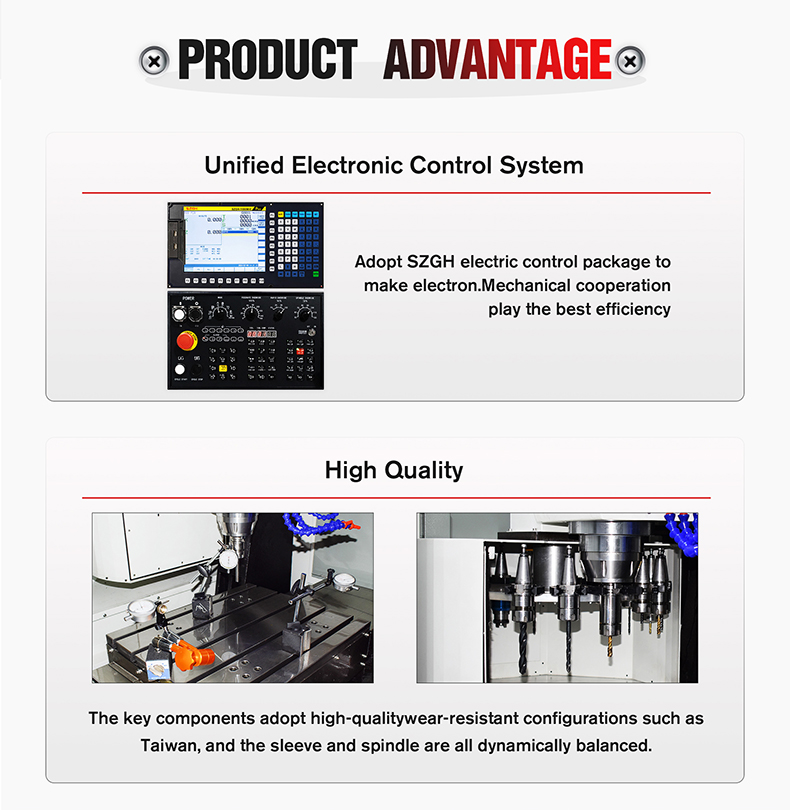In CNC machining, different workpieces have varying shapes, sizes, materials, and precision requirements, creating diverse demands for milling. SZGH's milling machines can meet diverse and customized CNC machining needs.
For example, planar workpieces require milling machines to maintain high flatness and surface roughness; grooved workpieces have stringent requirements for dimensional and shape accuracy; and gear machining demands even more precise tooth profiles and smooth transmission.
We will discuss milling processes for machining objects, including planes, grooves, gears, spiral grooves and helicoids, and complex curved surfaces, as well as CNC milling and milling controller processing methods.

(I) Typical Objects
1) Planes are one of the most common surfaces in mechanical parts. Many parts require milling to create planes as reference or mating surfaces. A part reference surface is a plane used as a positioning reference during part machining and assembly. Its accuracy directly impacts the machining accuracy of other surfaces and the assembly accuracy of the part. For example, when machining box-type parts, a datum surface is typically first machined on a milling machine, and then other surfaces are machined using this datum surface as a positioning reference.
2) The mold datum surface is a critical surface in mold manufacturing. The fit accuracy between the upper and lower molds, as well as the dimensional accuracy of the mold cavity, are closely related to the accuracy of the datum surface. The mold datum surface must not only maintain high flatness but also good surface finish to ensure stability and reliability during use. In modern mold manufacturing, CNC milling equipment is often used to machine these surfaces. The milling controller precisely controls the tool path and cutting parameters to meet high-precision requirements.

(II) Machining Methods
1) Milling machines can perform face milling: Face milling is a method of milling a flat surface using the end teeth of a face milling cutter. Face milling cutters have a large diameter, typically between 50 and 300 mm, and can machine a large surface area in a single operation. In CNC milling, during face milling, the milling controller precisely controls the tool axis perpendicular to the surface being machined, ensuring high cutting speeds, high machining efficiency, and minimal surface roughness and high flatness. This makes it suitable for machining large surfaces in mass production.
2) Milling machines can perform peripheral milling: Peripheral milling utilizes the circumferential teeth of the milling cutter to mill surfaces. Depending on the relationship between the milling cutter's rotation direction and the workpiece's feed direction, peripheral milling can be categorized as either down-cut milling or down-cut milling. On conventional milling machines, down-cut milling involves the cutter rotating in the same direction as the workpiece's feed direction, resulting in lower cutting forces and improved surface quality, but also prone to table movement. Down-cut milling involves the cutter rotating in the opposite direction of the workpiece's feed direction, resulting in higher cutting forces and relatively poorer surface quality, but more stable table operation. In CNC milling, the milling controller can effectively mitigate table movement during down-cut milling by precisely controlling the feed rate and spindle speed. Peripheral milling is suitable for machining small to medium-sized surfaces and surfaces with stepped surfaces.
3) Differences between end mills and face mills: End mills have teeth primarily distributed along the circumference of the cutter, with a small number of teeth also found on the end faces. They can perform both peripheral and face milling, but face milling has lower cutting efficiency and is primarily used for grooves, stepped surfaces, and small flat surfaces. In CNC milling, end mills offer greater flexibility, as the milling controller can flexibly adjust their motion trajectory based on machining requirements. Face mills have teeth primarily distributed along the end faces, with a small number of teeth also found on the circumference. They are primarily used for face milling, offering high cutting efficiency and precision, making them suitable for machining large flat surfaces.
(III) Application Examples
Machine Tool Fixture Part Processing: When machining a set of machine tool fixtures using an SZGH milling machine, multiple T-slots and keyways needed to be machined into the fixture base. Due to the high precision requirements for the fixture, the factory used CNC milling equipment for the process. When machining T-slots, a milling controller controls the machining process: first, an end mill is used to create a straight slot with a width of 16mm and a depth of 20mm. Then, a T-milling cutter is used to create a transverse slot with a width of 24mm and a depth of 10mm. A keyway milling cutter is used to create a keyway with a width of 10mm and a depth of 5mm. During rough milling, higher cutting parameters are used to improve efficiency, while lower cutting parameters are used for fine milling to ensure precision.
Customers from all over the world are welcome to contact SZGH for inquiries about CNC milling solutions. We are available 24 hours a day to answer your questions.

